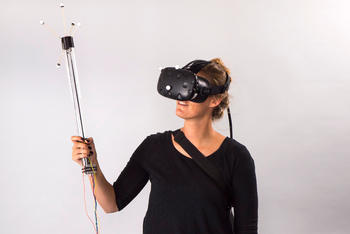Shifty: A Weight-Shifting Dynamic Passive Haptic Proxy
Shifty is a weight-shifting proxy object for Virtual Reality interaction. It lets you haptically feel the weight and transformation of virtual objects in VR!
We introduced Shifty and the underlying concept of Dynamic Passive Haptic Feedback in our TVCG paper Shifty: A Weight-Shifting Dynamic Passive Haptic Proxy to Enhance Object Perception in Virtual Reality.
Shifty shifts an internal mass while you interact with the virtual environment. Using appropriate visualizations in VR in synchronization with Shifty's changes in mass distribution (and thus the felt moment of inertia and lever arm), allows for immersive haptic experiences in VR. For more information on its haptic effect, the scientific background and user study results, please take a look at the paper.
Shifty was presented at the IEEE Virtual Reality Conference 2017 in Los Angeles.
To build your own, check out Shifty @ GitHub.
Abstract:
We define the concept of Dynamic Passive Haptic Feedback (DPHF) for virtual reality by introducing the weight-shifting physical DPHF proxy object Shifty. This concept combines actuators known from active haptics and physical proxies known from passive haptics to construct proxies that automatically adapt their passive haptic feedback. We describe the concept behind our ungrounded weight-shifting DPHF proxy Shifty and the implementation of our prototype. We then investigate how Shifty can, by automatically changing its internal weight distribution, enhance the user’s perception of virtual objects interacted with in two experiments. In a first experiment, we show that Shifty can enhance the perception of virtual objects changing in shape, especially in length and thickness. Here, Shifty was shown to increase the user’s fun and perceived realism significantly, compared to an equivalent passive haptic proxy. In a second experiment, Shifty is used to pick up virtual objects of different virtual weights. The results show that Shifty enhances the perception of weight and thus the perceived realism by adapting its kinesthetic feedback to the picked-up virtual object. In the same experiment, we additionally show that specific combinations of haptic, visual and auditory feedback during the pick-up interaction help to compensate for visual-haptic mismatch perceived during the shifting process.
